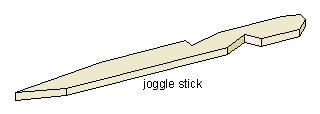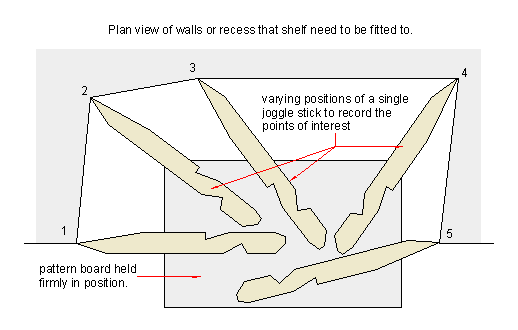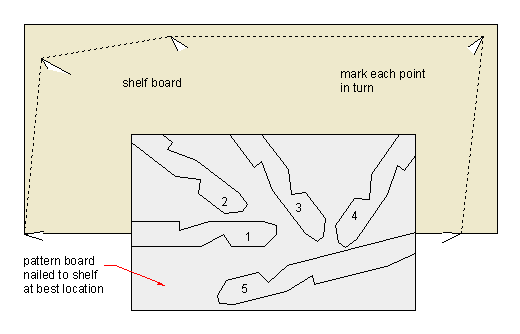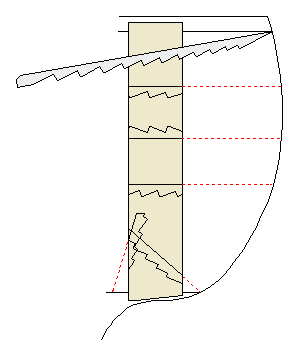The humble joggle stick
A couple of weeks ago I wrote a bit about the joggle stick or profiling batten in my "Winkles" newsletter. Here is a little bit more about this great little aid to scribing around tricky shapes.
What the heck is a joggle stick
 |
| Joggle stick- A boat builder's profiling batten. |
Here's a little tip that I have used a few times to help with tricky scribing jobs. See my scribing page for more details. I also talk about scribing in my coping saw page.
When I was younger and in my prime, I enjoyed many years sailing. Like a lot of others who fall for the lure of the sea, after a time I started to get the urge to build myself an offshore sailing boat, so I started learning as much as I could about boat building techniques.
This is a a method of using a home made batten to get an accurate plotting of points to enable us to cut complicated shapes easily.
 |
| Joggle Stick - A trim carpenter's one simply made out of scrap material. |
- The stick or batten can be any old piece of scrap timber, quickly made and thrown away after one use, or it can be quite sophisticated and kept and used in a workshop for years.
- The main thing is to have a point on one end, and some sort of notches on it that makes it easy to recognise and repeat the position.
- I have in the past quickly cut them out with a jig saw, or a hand saw.
- Don't make them too even an regular.
- Make them so that you instantly see which way up the stick was used.
- The sketch of the boat building one consists of a series of notches that grow steadily larger, so that no two of them could be confused with each other.
Back to top
Marking out a temporary board
 |
| Joggle stick- Using the stick to plot important points of a shelf, onto a temporary plotting board. |
Above is a sketch plan of an irregular recess in a wall. Let's say that we want o fit a shelf into it.
- First make up your joggle stick.
- Set up a temporary patten board, level and at the height that the shelf will be. This can be made out of scrap ply or Masonite. Anything that is clean and will show pencil marks clearly.
- The pattern need to be held firmly in position. Use clamps or temporary brace to keep it firm.
- Place the tip of the stick at each point that you want to record, with the base of the stick on the pattern and trace around the outline of the stick onto the pattern with a sharp pencil.
Back to top
Transferring the points
 |
| Joggle stick- Transferring the points onto the shelf to be cut. |
- Take the pattern and fix it firmly in position on the shelf material. Clamps or even nails will do, the main thing is that once again it should not move during the marking out.
- Place the joggle stick onto the penciled positions on the pattern, then pencil mark around the points on the shelf material to plot each point onto the shelf.
- Join the points up with a straight edge.
- Cut the shelf.
- Cross your fingers and say to yourself "hope it fits".
- Place the shelf in position, noting the perfect fit.
- If there is anyone within earshot, modestly say to them "crikey, we were lucky this time"
- Failure to comply with points 5 and 7 above will guarantee that the next one that you cut will turn out to be a right "pigs ear".
Back to top
An example for boat builders.
 |
| Joggle stick- The set up for getting the points to cut a bulkhead. |
Basically a repeat of what we had before, but working in a vertical plane.
- When points are close together or otherwise could be confused flip the stick.
- If the curves are large and fair (even with no bumps) then you don't need as many points plotted as on a lumpy surface.
- All boat builders have a series of battens of varying thickness that they can bend around (held by nails or weights) a series of points plotted with a joggle stick to draw a smooth even curve with.
I owned a few sailing boats, but I never did build one, (I made a few fast sailboards though!) What I did was sign on as crew on an old 1950's Sydney Hobart racer and we sailed around the Australian coast from Townsville to Darwin.
A magic trip that I thoroughly enjoyed.
At the same time it got the boat building bug out of my system and probably saved me thousands of dollars.
Leave this joggle stick page and back to home.






